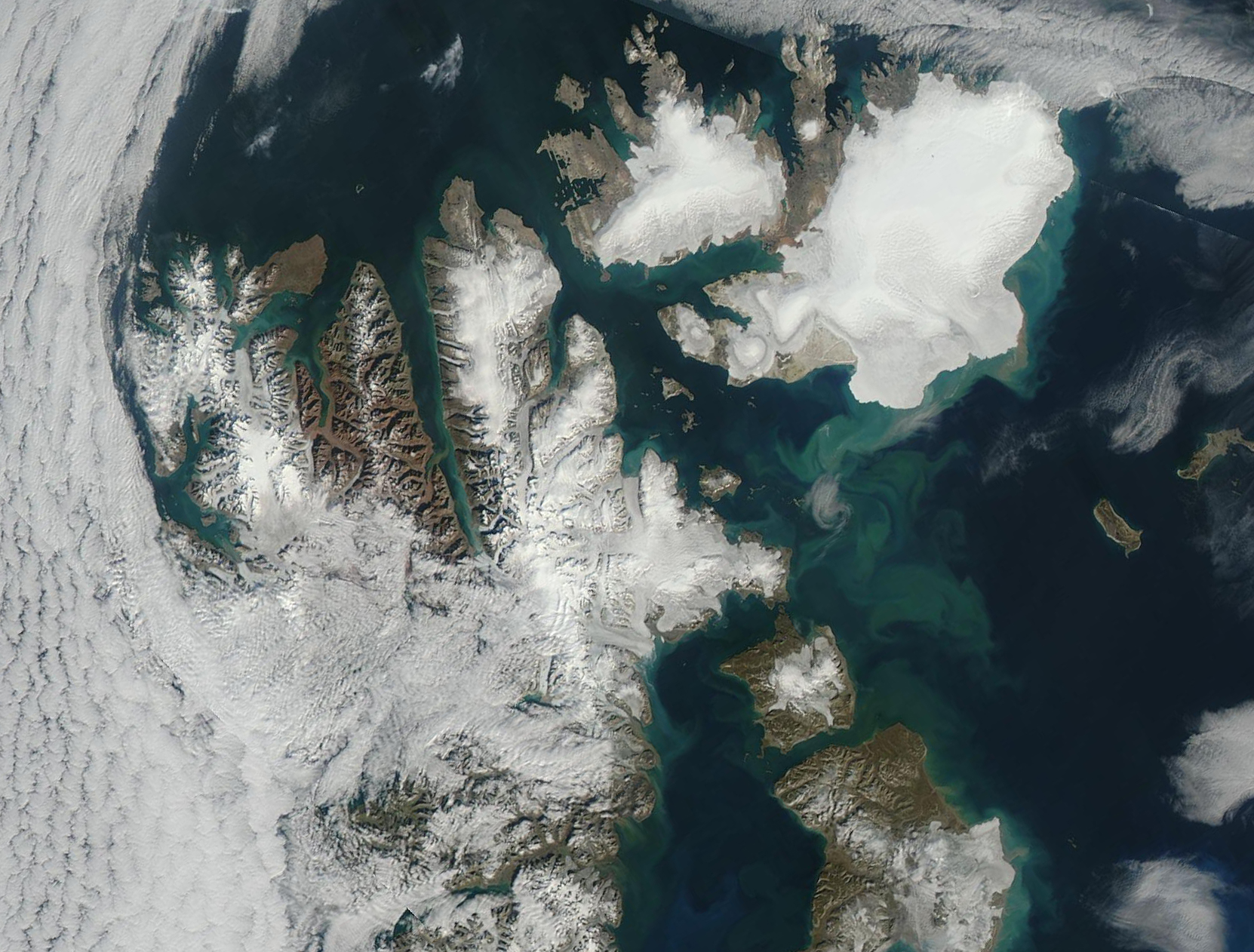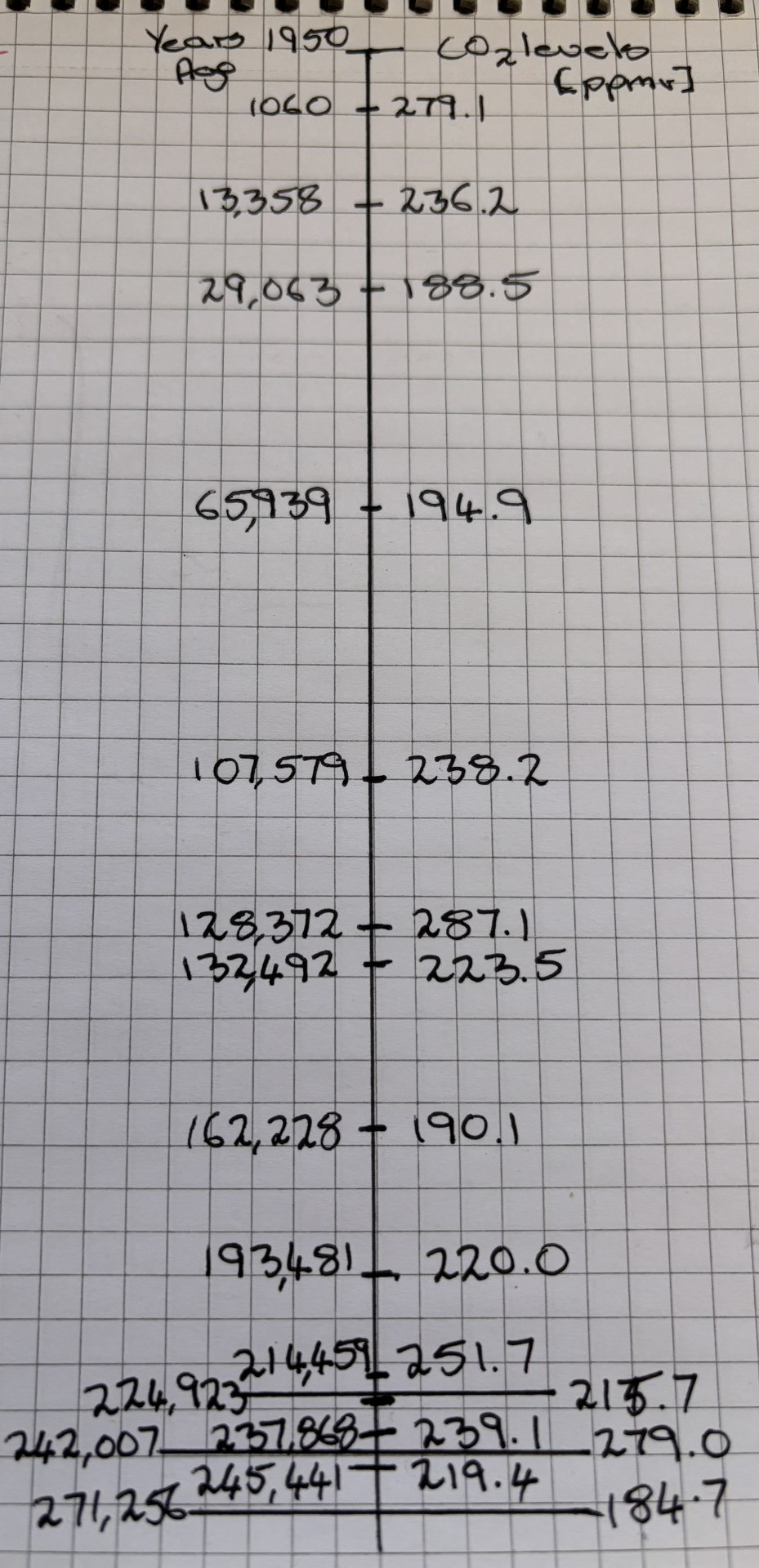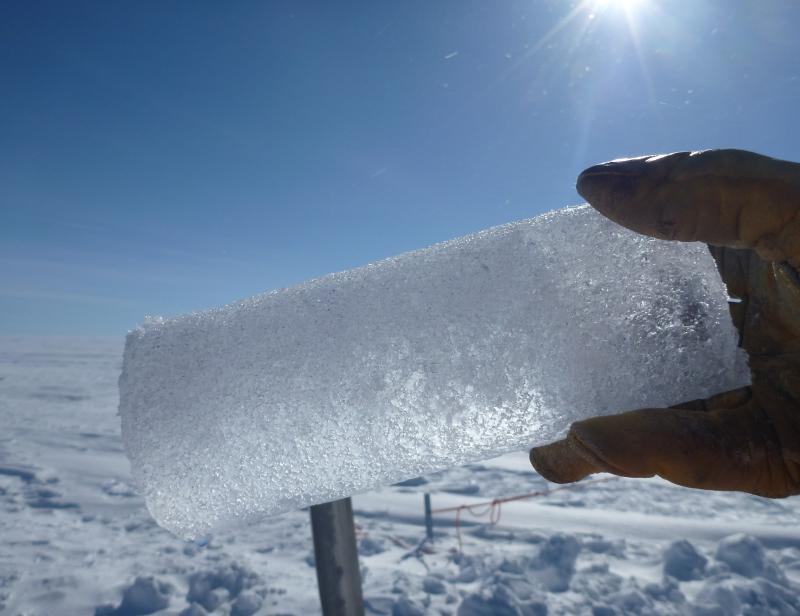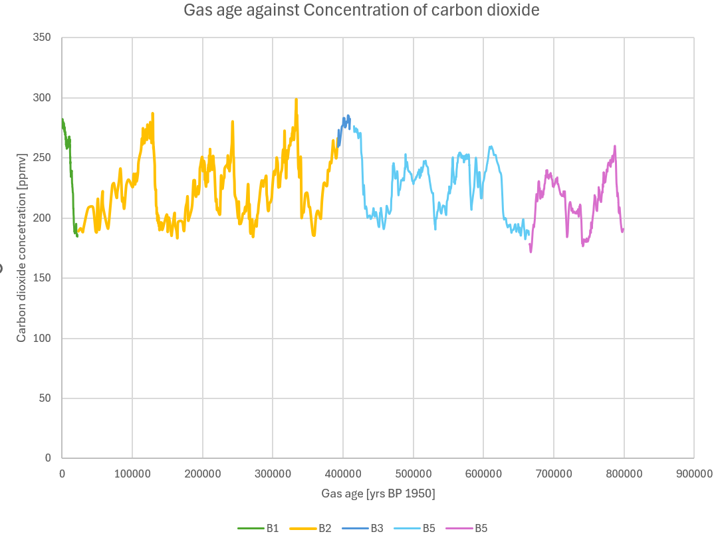Bushfire and ice
View Sequence overviewStudents will:
- examine the data provided by ice cores.
- use data from Australian scientists to create a graph that ‘tells a story’.
- compare current atmospheric carbon dioxide levels to historical records.
Students will represent their understanding as they:
- create a representation of the age and carbon dioxide levels in an ice core.
- use data to generate graphic representations of changing carbon dioxide levels over 800,000 years.
- describe the difference between correlation and causation.
- use argumentation processes in discussions.
In this lesson, assessment is formative.
Feedback might focus on:
- analysing representations of data from ice cores to identify patterns and trends in the amount of carbon dioxide in the atmosphere, highlighting inconsistencies.
- argumentation that links claim and evidence through reasoning.
- explanations of how scientific knowledge is validated and refined, including the role of conferences and peer review.
- analysing and connecting data to identify and explain patterns and trends, relationships and anomalies.
- the validity of data when extrapolating from a graph.
Potential summative assessment
Students working at the achievement standard should:
- explain how scientific knowledge is validated and refined, including the role of publication and peer review.
- examine how the values and needs of society influence the focus of scientific research.
- be able to explain how interactions within and between Earth’s sphere affect the carbon cycle.
- select and construct appropriate representations to organise, process and summarise data and information.
- analyse and connect data and information to identify and explain patterns, trends, relationships, and anomalies.
- analyse the impact of assumptions and sources of error in methods and evaluate the validity of conclusions and claims.
- construct logical arguments based on evidence to support conclusions and evaluate claims.
- select and use content, language, and text features effectively to achieve their purpose when communicating their ideas, findings, and arguments to specific audiences.
Refer to the Australian Curriculum content links on the Our design decisions tab for further information.
Whole class
Bushfire and ice Resource PowerPoint
Access to internet and YouTube for videos on bushfires
Carbon cycle game Resource sheet
Optional: 114 years of Australian temperatures poster from the Bureau of Meteorology
Each group
Roll of paper (paper towel etc.) 2.15 m long, or graph paper 22 cm long
Measuring tape or ruler
Texta or permanent marker
Sticky notes
Each student
Ice core Data resource
Spreadsheet software
Lesson
The Inquire phase allows students to cycle progressively and with increasing complexity through the key science ideas related to the core concepts. Each Inquire cycle is divided into three teaching and learning routines that allow students to systematically build their knowledge and skills in science and incorporate this into their current understanding of the world.
When designing a teaching sequence, it is important to consider the knowledge and skills that students will need in the final Act phase. Consider what the students already know and identify the steps that need to be taken to reach the level required. How could you facilitate students’ understanding at each step? What investigations could be designed to build the skills at each step?
Read more about using the LIA FrameworkRe-orient
Recall:
- the four ‘spheres’ where carbon can be found.
- examples of carbon molecules that can be found in the atmosphere.
The Inquire phase allows students to cycle progressively and with increasing complexity through the key science ideas related to the core concepts. Each Inquire cycle is divided into three teaching and learning routines that allow students to systematically build their knowledge and skills in science and incorporate this into their current understanding of the world.
When designing a teaching sequence, it is important to consider the knowledge and skills that students will need in the final Act phase. Consider what the students already know and identify the steps that need to be taken to reach the level required. How could you facilitate students’ understanding at each step? What investigations could be designed to build the skills at each step?
Read more about using the LIA FrameworkIdentifying and constructing questions is the creative driver of the inquiry process. It allows students to explore what they know and how they know it. During the Inquire phase of the LIA Framework, the Question routine allows for past activities to be reviewed and to set the scene for the investigation that students will undertake. The use of effective questioning techniques can influence students’ view and interpretation of upcoming content, open them to exploration and link to their current interests and science capital.
When designing a teaching sequence, it is important to spend some time considering the mindset of students at the start of each Inquire phase. What do you want students to be thinking about, what do they already know and what is the best way for them to approach the task? What might tap into their curiosity?
Read more about using the LIA FrameworkAtmospheric carbon dioxide
Pose the question: Does it matter if atmospheric carbon dioxide levels change?
Discuss recent media reports on the changes in climate as a result of increased carbon dioxide levels.
Pose the question: Have atmospheric carbon dioxide levels always been the same?
Global cycles of temperature and carbon dioxide
Global variations in temperature have occurred in the past 800,000 years.

Global variations in temperature in the past 800,000 years have largely been a result of periodic changes in the orbit of the Earth around the Sun. These changes fall into three types of orbital cycles (Precession, Obliquity, and Eccentricity) called the Milankovitch cycles. These cycles change the Earth’s axis of rotation, the tilt of the Earth’s axis, and the shape of the Earth’s orbit respectively. All three impact the average temperature of the Earth, resulting in ice ages that trap much of the water on the Earth’s surface as ice.
In past ice ages, the water level dropped by up to 120 metres from current levels. Exposing more land allowed plant life to expand and take up more carbon dioxide. The colder water also absorbed higher levels of carbon dioxide. This is the reason why graphs show a decreased level of carbon dioxide when global temperatures decrease.
The increase in glacial ice formed a positive feedback system where the white ice reflects a greater amount of sunlight into the atmosphere, allowing the Earth’s temperature to decrease further. The glacial ice also grounds surrounding rocks, releasing nutrients into the water and supporting food webs.
In the past, the average temperature of the Earth increased as its orbit changed once again.
Current global warming is different from this slow process. This time it is being driven by the increase in carbon dioxide as a result of industrial combustion and is occurring at a faster rate (50-100 years instead of 1000s of years).
Global variations in temperature in the past 800,000 years have largely been a result of periodic changes in the orbit of the Earth around the Sun. These changes fall into three types of orbital cycles (Precession, Obliquity, and Eccentricity) called the Milankovitch cycles. These cycles change the Earth’s axis of rotation, the tilt of the Earth’s axis, and the shape of the Earth’s orbit respectively. All three impact the average temperature of the Earth, resulting in ice ages that trap much of the water on the Earth’s surface as ice.
In past ice ages, the water level dropped by up to 120 metres from current levels. Exposing more land allowed plant life to expand and take up more carbon dioxide. The colder water also absorbed higher levels of carbon dioxide. This is the reason why graphs show a decreased level of carbon dioxide when global temperatures decrease.
The increase in glacial ice formed a positive feedback system where the white ice reflects a greater amount of sunlight into the atmosphere, allowing the Earth’s temperature to decrease further. The glacial ice also grounds surrounding rocks, releasing nutrients into the water and supporting food webs.
In the past, the average temperature of the Earth increased as its orbit changed once again.
Current global warming is different from this slow process. This time it is being driven by the increase in carbon dioxide as a result of industrial combustion and is occurring at a faster rate (50-100 years instead of 1000s of years).
The Inquire phase allows students to cycle progressively and with increasing complexity through the key science ideas related to the core concepts. Each Inquire cycle is divided into three teaching and learning routines that allow students to systematically build their knowledge and skills in science and incorporate this into their current understanding of the world.
When designing a teaching sequence, it is important to consider the knowledge and skills that students will need in the final Act phase. Consider what the students already know and identify the steps that need to be taken to reach the level required. How could you facilitate students’ understanding at each step? What investigations could be designed to build the skills at each step?
Read more about using the LIA FrameworkThe Investigate routine provides students with an opportunity to explore the key ideas of science, to plan and conduct an investigation, and to gather and record data. The investigations are designed to systematically develop content knowledge and skills through increasingly complex processes of structured inquiry, guided inquiry and open inquiry approaches. Students are encouraged to process data to identify trends and patterns and link them to the real-world context of the teaching sequence.
When designing a teaching sequence, consider the diagnostic assessment (Launch phase) that identified the alternative conceptions that students held. Are there activities that challenge these ideas and provide openings for discussion? What content knowledge and skills do students need to be able to complete the final (Act phase) task? How could you systematically build these through the investigation routines? Are there opportunities to build students’ understanding and skills in the science inquiry processes through the successive investigations?
Read more about using the LIA FrameworkIce core data
Refer to the Carbon cycle game Resource sheet to identify where atmospheric carbon dioxide could go—it can remain in the atmosphere, or move to the biosphere or hydrosphere.
(Slide 42) Discuss how carbon dioxide in the hydrosphere can be trapped when ice is formed in the Antarctic. This allows scientists to see how the levels of carbon have changed over time by drilling ice cores. An ice core is a column of ice about 15 cm wide. It has hundreds of layers of ice. The deeper you go, the older the ice.
Watch the video What the Antarctic ice cores tell us about climate change (2:35).
Introduce the work of Dr Andrew Smith, a principal research scientist at ANSTO, who works with atmospheric scientists and glaciologists to measure the amount of radiocarbon that is trapped as carbon dioxide at two sites in the Antarctic ice. Some of his data on 800,000-year-old ice is available for students to use.
(Slide 43) Explain how students have access to real data gathered by Australian scientists that can be used to examine how carbon dioxide levels have changed over time.
Discuss how we know that this data is reliable.
- Where do we get the data?
- Made available through open source for all scientists around the world. This means it is checked before being used by other scientists.
- Who collects the ice cores? How do we know?
- A group of scientists from different groups often collaborate for the expeditions. The data comes from multiple ice cores that are compared from different locations.
- How do we know the ice cores are stored appropriately?
- This is reported as part of submitting a peer-reviewed article that is published.
Optional: Discuss how radioactive elements (such as beryllium-10, chlorine-36, and carbon-14) can be used to determine the age of the ice or the gases caught in the ice.
Making an ice core
Provide students with the Ice core Data resource.
Explain that students will make a model ice core using a sample of data points taken from this data. Provide each group of students with a roll of paper at least 2.15 m long to represent the ice core (this looks effective when placed up a wall as a display). Alternatively, graph paper that is 22 cm long could be used, although the final measurements can be millimetres apart.
✎ STUDENT NOTES: Use the data to draw an ice core and describe where and how it is generated:
- Select data from the ‘Making Ice Core’ tab at the base of the Excel spreadsheet.
- Draw a line down the centre of the paper roll.
- Mark one end of the paper roll as the closest to the surface level as the start of the ice core. This ice is from 1950 (T=0).
- Label the left-hand side of the line ‘Years ago’.
- Label the right-hand side of the paper ‘Carbon dioxide level [ppmv]’ (ppmv = concentration of parts per million in volume).
- Measure the distance from the top of the ice core.
- Record the age of the gas and the carbon dioxide level at each location on the paper roll.

(Slide 44) Discuss the data shown on the model ice core and how well the model represents the type of data used by scientists.
✎ STUDENT NOTES: Explain what the model shows and the limitations of this model.
- What does the model ice core tell us about the levels of carbon dioxide over time?
- The concentration of carbon dioxide varies between 180-300 ppmv.
- Is the amount of ice identical for each time period?
- No. Some decades/centuries there is more ice than others.
- What could affect the amount of ice that forms each decade/century?
- The amount of rainfall/snowfall, the temperatures.
- How effective is this model in representing the carbon dioxide levels over time?
- It helps to represent how the age of the ice (and trapped carbon dioxide) increases with depth.
- What are the limitations of such a model?
- It is very simplified and difficult to see the details of carbon dioxide change, it does not show all the data—only 350,000 years instead of 800,000 years.
Optional: Produce a large model of the ice core, to be placed on a wall of the science room.
Graphing carbon dioxide data
(Slide 45) Explain that graphs are another way to represent the data (how the carbon dioxide levels have varied over the last 800,000 years).
Divide groups of students according to their abilities and select the appropriate data tabs from Ice core Data resource.
There are four sets of data provided as part of this activity.
Making Ice Core: a simplified set of data with 18 data points.
Group A: the complete set of data as provided by ANSTO scientists. It is an amalgamation of data from the EPICA (European Project for Ice Coring in Antarctica) Dome C ice core covering 0 to 800 kyr BP (thousand years before present). The different colours represent the different sets of data.
Group B: the complete set of data as provided by ANSTO scientists. It is broken into five separate ice cores (B1-B5) that together provide a complete picture of the last 800,000 years. This could be used for different groups of students playing the role of collaborating research labs. The data could be compared between the labs in a peer review process.
Group C: the pre-graphed data for those students who may have limited ability to use a computer or excel spreadsheets.
Guide the students through the process of creating a chart:
- Select/highlight two columns ‘Age of the gas’ and ‘CO2 concentration’ columns in the tables.
- Select ‘Insert’ and ‘Scatter Graph with smooth lines and markers’ in the ‘Charts’ section of the top ribbon of the Excel spreadsheet.

- Select ‘Chart design’ from the top of the page.
- Select ‘Add Chart Element’ from the LHS of the top ribbon to add a title for the graph and axis labels.
Ice cores
Ice cores provide records of carbon dioxide levels in the past.

Glaciers are slow moving masses or rivers of ice. They are formed by layers of snow being buried by more snow each year. Over time, each layer with unique compositions and textures becomes compacted. The layers of ice form a record of the climate conditions including snowfall, temperature, atmospheric gases, and volcanic activity.
Scientists use hollow rotating drills to remove a cylinder of ice vertically from a glacier to examine the ‘time capsule’ of information on global changes.
Other analyses include:
- the number of layers as an indication of age.
- solid and dissolved impurities in ice: environmental changes, measure dust, salts, and pollutants (humans and volcanoes).
- air bubbles: Measure C14 in fossil methane and carbon monoxide (caused by burning fossil fuels).
- proportion of hydrogen and oxygen isotopes in melted and refrozen water is different from that of continuously frozen water. Measuring this is an indication and record of changing temperatures over time.
- analyse beryllium-10, chlorine-36, and carbon-14 as indications of solar radiation over time.
Glaciers are slow moving masses or rivers of ice. They are formed by layers of snow being buried by more snow each year. Over time, each layer with unique compositions and textures becomes compacted. The layers of ice form a record of the climate conditions including snowfall, temperature, atmospheric gases, and volcanic activity.
Scientists use hollow rotating drills to remove a cylinder of ice vertically from a glacier to examine the ‘time capsule’ of information on global changes.
Other analyses include:
- the number of layers as an indication of age.
- solid and dissolved impurities in ice: environmental changes, measure dust, salts, and pollutants (humans and volcanoes).
- air bubbles: Measure C14 in fossil methane and carbon monoxide (caused by burning fossil fuels).
- proportion of hydrogen and oxygen isotopes in melted and refrozen water is different from that of continuously frozen water. Measuring this is an indication and record of changing temperatures over time.
- analyse beryllium-10, chlorine-36, and carbon-14 as indications of solar radiation over time.
Differentiating investigations
Differentiated investigations allow all students the opportunity to achieve.

Students come to the classroom with a variety of digital skills and capabilities. How teachers address these differences is called differentiation.
There are multiple ways to tailor the learning for students, including:
- modifying the content—the teacher makes changes to the amount of content or the way it is presented to the student.
- modifying the process—the teacher makes changes to a specific activity, so the learning of the content is attainable.
- modify the product—the teacher makes changes to the criteria or level of mastery that is required of the student.
In this activity, different sets of data are provided so that the teacher can modify the process, enabling students to develop a full understanding of the content involved.
Students come to the classroom with a variety of digital skills and capabilities. How teachers address these differences is called differentiation.
There are multiple ways to tailor the learning for students, including:
- modifying the content—the teacher makes changes to the amount of content or the way it is presented to the student.
- modifying the process—the teacher makes changes to a specific activity, so the learning of the content is attainable.
- modify the product—the teacher makes changes to the criteria or level of mastery that is required of the student.
In this activity, different sets of data are provided so that the teacher can modify the process, enabling students to develop a full understanding of the content involved.
The Inquire phase allows students to cycle progressively and with increasing complexity through the key science ideas related to the core concepts. Each Inquire cycle is divided into three teaching and learning routines that allow students to systematically build their knowledge and skills in science and incorporate this into their current understanding of the world.
When designing a teaching sequence, it is important to consider the knowledge and skills that students will need in the final Act phase. Consider what the students already know and identify the steps that need to be taken to reach the level required. How could you facilitate students’ understanding at each step? What investigations could be designed to build the skills at each step?
Read more about using the LIA FrameworkFollowing an investigation, the Integrate routine provides time and space for data to be evaluated and insights to be synthesized. It reveals new insights, consolidates and refines representations, generalises context and broadens students’ perspectives. It allows student thinking to become visible and opens formative feedback opportunities. It may also lead to further questions being asked, allowing the Inquire phase to start again.
When designing a teaching sequence, consider the diagnostic assessment that was undertaken during the Launch phase. Consider if alternative conceptions could be used as a jumping off point to discussions. How could students represent their learning in a way that would support formative feedback opportunities? Could small summative assessment occur at different stages in the teaching sequence?
Read more about using the LIA FrameworkMaking sense of the data
Ask students to describe how the carbon dioxide levels have increased and decreased over time, making reference to their graphs.
✎ STUDENT NOTES: Use argumentation processes to make claims about the data (claim, evidence, and reasoning that link everything together).
- How does the carbon dioxide levels change over time?
- How many peaks in carbon dioxide levels have there been in the past 800,000 years?
- What might have caused more carbon to be released into the atmosphere in the past?
- Warming oceans release carbon dioxide and decrease plant life due to rising water levels. See the embedded PL.
- What is the lowest level of carbon dioxide shown in the graphs?
- What is the highest level shown in the graphs?
- Could we extrapolate the graph to predict what the current carbon dioxide level might be?
- No. Extrapolating off a graph is not valid as it is outside the tested limits of the data. This point will be reinforced when examining cultural burning in Lesson 6.
Discuss how at conferences scientists will often display their results to discuss and compare inferences that are made as a result of data. Set up a gallery walk (similar to a simplistic poster display) where students examine each other's graphs and the argumentation processes that were made. Encourage students to identify any counterclaims that may be made.
- Which group has the most recent data set (fewest years ago)?
- Which group has the oldest data set (most years ago)?
- Can we put them in order of youngest to oldest?
- Is the data consistent (do they show the same pattern)?
- Why do scientists need to review the data with their peers?
- To check that their results are valid and consistent with the results found by others.
- How is this usually done in science laboratories?
- At conferences, or publishing peer-reviewed papers.
(Slide 47) Discuss the peer-reviewed graph that combines data from multiple sources.

✎ STUDENT NOTES: Describe the ‘story’ told by the data.
Compare the previous highest levels of carbon dioxide to the current level from Cape Grim TAS or Hawaii.
✎ STUDENT NOTES: Locate this value on your own graph (it is off the scale).
Discuss if this value is an anomaly (a single unusual event) or part of a pattern. Use the values determined by CSIRO at Cape Grim to identify that there has been a slow but significant increase over the last 40 years. The current carbon dioxide value is part of a larger pattern that has been peer-reviewed by scientists.
- How do we know if the Cape Grim result is accurate?
- It can be checked against other values for carbon dioxide. For example NASA.
- Using what we know about the fast and slow carbon cycle, what is the most likely cause of the high carbon dioxide level?
- The carbon trapped in the slow cycle fossil fuel has been released into the atmosphere through combustion.
- Is carbon dioxide the only greenhouse gas?
- No. Water, methane, and other industrial gases (nitrous oxide and fluorocarbons) are greenhouse gases.
- How is this affecting us?
- Why is it important to fund this research now? Why wasn’t it researched as much 50 years ago?
- Less money was provided 50 years ago for this research as global warming wasn’t seen as a big enough problem then.
Optional: Show the students the 114 years of Australian temperatures poster from the Bureau of Meteorology for more recent information on changing temperatures.
Optional: Discuss how some scientists are currently working to reduce the amount of carbon dioxide being produced or remove it from the atmosphere.
(Slide 48-49) Discuss the link between bushfires and carbon dioxide levels. Bushfires are combustion reactions that release carbon dioxide, but plants grow quickly after a bushfire, absorbing carbon dioxide. Over time, bushfires are expected to be carbon neutral.
- Do bushfires increase the level of carbon dioxide in the atmosphere?
- Bushfires temporarily increase the level of carbon dioxide levels in the air.
- What does a bushfire area look like 1 year later, 5 years later, 10 years late?
- Once an area has been cleared by fire, many plants grow quickly and take up large amounts of carbon dioxide from the atmosphere. Therefore, bushfires have no net effect on carbon dioxide levels. (Discuss the meaning of the term ‘net’.)
- Do you think bushfires contribute to the overall carbon dioxide levels?
- Bushfires do not contribute directly to global warming.
✎ STUDENT NOTES: Write your own conclusion about the impact of bushfires on carbon dioxide levels in the atmosphere.
In the following optional lesson, you can examine the link between carbon dioxide levels and global warming.
Reflect on the lesson
You might:
- encourage students to examine how the greenhouse gases contribute to global warming through the simulation websites.
- encourage students to calculate their carbon footprint.
- re-examine the intended learning goals for the lesson and consider how they were achieved.
- discuss how students were thinking and working like scientists during the lesson.